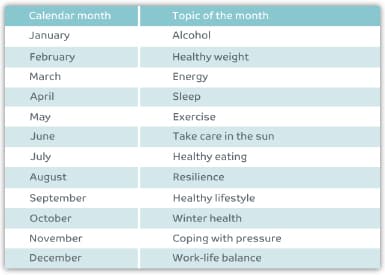Less than half (49%) of people across the EU feel as though their workplace is a psychologically and emotionally healthy place to work. By implementing wellbeing strategies for employees, businesses can increase morale and productivity and reduce staff absences.
Prioritising employee health all year-round acts as preventative measure instead of a reaction when someone is already feeling unwell. There are a number of products and initiatives that can benefit businesses to ensure that support is consistent.
1. Collect regular employee feedback
There is no ‘one shoe fits all’ approach to a wellbeing strategy. One of the most effective ways to ensure that employees are consistently engaging with wellbeing throughout the year is to go to gather employee feedback. You can see what is effective for your team and highlight areas for improvement to make sure it is the right match.
Understanding that wellbeing strategies are an ongoing plan and will require persistent updates and check-ins is vital to ensuring that employees’ needs are met. Collecting feedback not only gives you the information you need to ensure that your wellbeing strategy is the right fit, but it shows that employees are being heard and gives space to adapt to evolving wants and needs.
2. Make wellbeing part of the ‘norm’
Work-related stress, anxiety or depression accounts for over half of working days lost due to ill health. By encouraging open, honest conversations surrounding mental health and wellbeing, you can create a positive workplace culture that allows employees to feel comfortable, safe and heard. With over half of employees lying about absences due to mental health through an Aetna international survey, supporting employees with their mental health and wellbeing is critical to creating a happy environment.
Businesses can create space for these conversations in many ways, including:
- Displaying wellbeing-positive displays in the for discussion prompts and ways to support self-care
- Wellbeing-specific meetings to create a space for these conversations
- Encouraging workplace social activities to build trust within employee relationships
3. Use a wellbeing planner
To help bridge the gap between wellbeing for remote and onsite workers, you can utilise a wellbeing planner which provides regular touchpoints for employees. You and your team access health resources to improve your knowledge around key wellbeing topics and open up conversations to encourage engagement with their health.
The Wellbeing Planner has resources to engage with each month based on a topic of your choice to help your workforce focus on areas to better their wellbeing.
Here’s a sample wellbeing planner with some topic examples:

These are easy to deliver across multiple formats to provide flexibility for employee learning styles such as videos, podcasts, fact sheets and personal training plans.
4. Start with small changes
Take wellbeing into action by adding some healthier habits into your day-to-day business. With the average full time worker in Europe spending 36.1 hours per week at their job, adding in healthier habits as part of your workplace culture or employee benefits will have a great impact on their overall wellbeing.
Some examples include:
- Opting for walking meetings creates a healthier, more inclusive culture that is beneficial to physical health and boosts creativity by 81%.
- Corporate volunteering initiatives have been found to improve life satisfaction, increase happiness and decrease symptoms of depression.
- Work social activities give a greater sense of belonging and build personal relationships.
5. Keep learning as a team
A study by Open University revealed that 1 in 4 (28%) see an immediate improvement in overall wellbeing when learning and development programmes are implemented in employee benefits. Learning new skills can raise self-esteem and bring a greater sense of purpose to employment. This can have a profound effect on overall wellbeing; employees with access to this see a 36% increase in improved stress and mental health management.
4 in 10 European managers lack essential training. This can lead to a disconnect between managers and employees as they do not have the skillset to lead effectively. By showing continued training, this also role models behaviour and sets an example within the business, as well as being more apt to support staff. This can have a profound effect on overall wellbeing. Learning as a team helps exercise active listening and speaking in a group which can lead to cohesion and morale amongst your workers.

